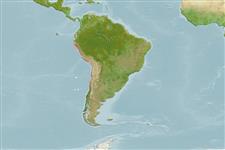Common names from other countries
Environment: milieu / climate zone / depth range / distribution range
Οικολογία
; εύρος βάθους 0 - 20 m (Ref. 114693). Tropical, preferred 15°C (Ref. 107945); 5°S - 43°S, 81°W - 70°W (Ref. 114682)
Southern Pacific: From Sechura, Peru to Chiloé, Chile. Tropical and subtropical.
Length at first maturity / Μέγεθος / Βάρος / Age
Maturity: Lm ? range ? - ? cm Max length : 7.0 cm ShL αρσενικό/απροσδιόριστο; (Ref. )
Lives in the swash zone of exposed high-energy intermediate and dissipative sandy beaches. Usually burrows to a depth of around 10 cm, but can reach 25 cm if disturbed. Adults are mainly restricted to the surf zone while most of the juveniles to the swash zone (Ref. 106909). Intertidal to subtidal (Ref. 113820).
Life cycle and mating behavior
Γεννητική Ωρίμανση | Αναπαραγωγή | Γεννοβολία | Αβγά | Γονιμότητα | Προνύμφες
Members of the class Bivalvia are mostly gonochoric, some are protandric hermaphrodites. Life cycle: Embryos develop into free-swimming trocophore larvae, succeeded by the bivalve veliger, resembling a miniature clam.
SAUP Database. 2006. (Ref. 356)
IUCN Red List Status (Ref. 130435)
CITES status (Ref. 108899)
Not Evaluated
Not Evaluated
Human uses
αλιεία: Εμπορικό(ά)
FAO - αλιεία: landings | FishSource | Η θάλασσα γύρω μας
Εργαλεία
Περισσότερες πληροφορίες
Age/SizeΑύξησηLength-weightLength-lengthΜορφολογίαΠρονύμφεςΑφθονία
Διαδικτυακές πηγές
Estimates based on models
Preferred temperature
(Ref.
115969): 11.8 - 21.9, mean 17.4 (based on 30 cells).
Ελαστικότητα
Υψηλό, ελάχιστος χρόνος για διπλασιασμό πληθυσμού < 15 μήνες (K=1.13).
Vulnerability
Low vulnerability (10 of 100).
